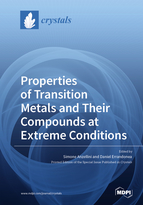Properties of Transition Metals and Their Compounds at Extreme Conditions
A special issue of Crystals (ISSN 2073-4352). This special issue belongs to the section "Crystalline Metals and Alloys".
Deadline for manuscript submissions: closed (31 May 2021) | Viewed by 36349
Special Issue Editors
Interests: characterization of materials under extreme conditions of pressure and temperature; phase diagrams; melting curves; equation of states; diamond anvil cells; synchrotron X-ray diffraction and absorption spectroscopy
Special Issues, Collections and Topics in MDPI journals
Interests: high-pressure; phase transitions; oxides; X-ray diffraction; novel technological materials
Special Issues, Collections and Topics in MDPI journals
Special Issue Information
Dear Colleagues,
The characterisation of the physical and chemical properties of transition metals and their compounds under extreme conditions of pressure and temperature has always attracted the interest of a wide scientific community. Their properties have numerous implications in fields ranging from solid-state physics, chemistry and materials science to Earth and planetary science.
In the last few decades, thanks to advancements in experimental techniques and computer simulations, the rate of new important discoveries in this field has significantly increased: from the prediction and the experimental observation of new ultra-hard materials to the combined characterisation of textural, structural, magnetic and chemical pressure-induced evolutions; and from the possible observation of topological transitions in the Fermi surface for valence electrons to newly predicted pressure-induced core level crossing transitions.
The present Special Issue provides a forum for describing and discussing contemporary achievements in extreme conditions research. In particular, the authors are invited to contribute articles presenting new experimental and theoretical advances related to this field. Contributions discussing pressure (temperature)-induced evolution of electronic, magnetic or structural properties of transition metals, as well as phase diagrams, melting curves and equation of states of geophisically relevant compounds are welcome. Discussions on the mechanism of these transformations and their influence on the physical and chemical properties are also welcome. The volume is also open to feature and short review articles of current hot topics.
Dr. Simone Anzellini
Prof. Dr. Daniel Errandonea
Guest Editors
Manuscript Submission Information
Manuscripts should be submitted online at www.mdpi.com by registering and logging in to this website. Once you are registered, click here to go to the submission form. Manuscripts can be submitted until the deadline. All submissions that pass pre-check are peer-reviewed. Accepted papers will be published continuously in the journal (as soon as accepted) and will be listed together on the special issue website. Research articles, review articles as well as short communications are invited. For planned papers, a title and short abstract (about 100 words) can be sent to the Editorial Office for announcement on this website.
Submitted manuscripts should not have been published previously, nor be under consideration for publication elsewhere (except conference proceedings papers). All manuscripts are thoroughly refereed through a single-blind peer-review process. A guide for authors and other relevant information for submission of manuscripts is available on the Instructions for Authors page. Crystals is an international peer-reviewed open access monthly journal published by MDPI.
Please visit the Instructions for Authors page before submitting a manuscript. The Article Processing Charge (APC) for publication in this open access journal is 2600 CHF (Swiss Francs). Submitted papers should be well formatted and use good English. Authors may use MDPI's English editing service prior to publication or during author revisions.
Keywords
- Extreme conditions research
- Phase transitions
- Structural, electronic and magnetic properties
- Textural evolution
- Phase diagrams modelling and characterisation
- New materials
- Equation of state
- Melting curves
- Symmetry-breaking






